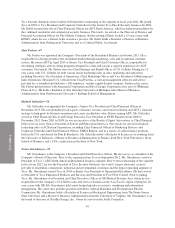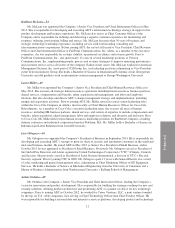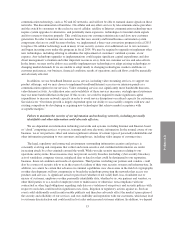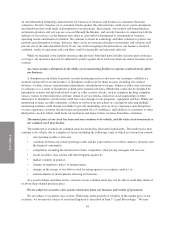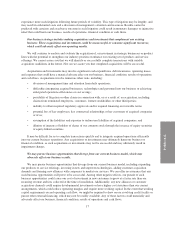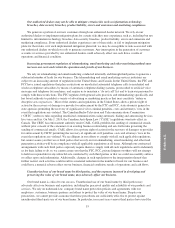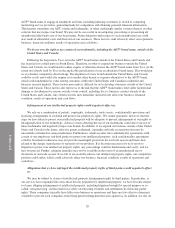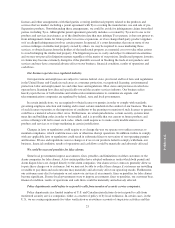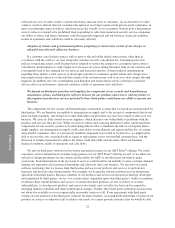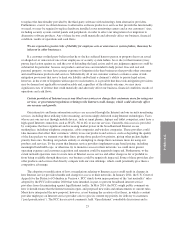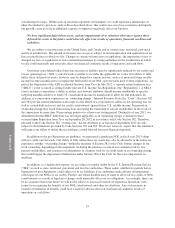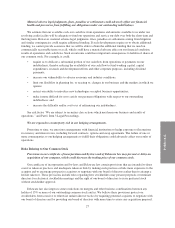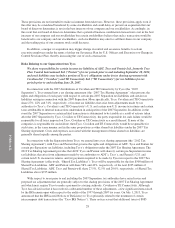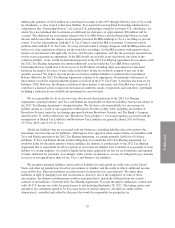ADT 2014 Annual Report Download - page 85
Download and view the complete annual report
Please find page 85 of the 2014 ADT annual report below. You can navigate through the pages in the report by either clicking on the pages listed below, or by using the keyword search tool below to find specific information within the annual report.
FORM 10-K
Our authorized dealers may not be able to mitigate certain risks such as information technology
breaches, data security breaches, product liability, errors and omissions and marketing compliance.
We generate a portion of our new customers through our authorized dealer network. We rely on our
authorized dealers to implement mitigation plans for certain risks they may experience such as, including but not
limited to, information technology breaches, data security breaches, product liability, errors and omissions and
marketing compliance. If our authorized dealers experiences any of these risks, or fail to implement mitigation
plans for their risks, or if such implemented mitigation plans fail, we may be susceptible to risks associated with
our authorized dealers on which we rely to generate customers. Any interruption in the generation of customer
accounts or services provided by our authorized dealers could adversely affect our cash flows, results of
operations and financial condition.
Increasing government regulation of telemarketing, email marketing and other marketing methods may
increase our costs and restrict the operation and growth of our business.
We rely on telemarketing and email marketing conducted internally and through third parties to generate a
substantial number of leads for our business. The telemarketing and email marketing services industries are
subject to an increasing amount of regulation in the United States and Canada. In the United States, the FTC and
FCC have issued regulations that place restrictions on unsolicited automated telephone calls to residential and
wireless telephone subscribers by means of automatic telephone dialing systems, prerecorded or artificial voice
messages and telephone fax machines, and require us to maintain a “do not call” list and to train our personnel to
comply with these restrictions. The FTC regulates both general sales practices and telemarketing specifically and
has broad authority to prohibit a variety of advertising or marketing practices that may constitute “unfair or
deceptive acts or practices.” Most of the statutes and regulations in the United States allow a private right of
action for the recovery of damages or provide for enforcement by the FTC and FCC, state attorneys general or
state agencies permitting the recovery of significant civil or criminal penalties, costs and attorneys’ fees in the
event that regulations are violated. The Canadian Radio-Television and Telecommunications Commission
(“CRTC”) enforces rules regarding unsolicited communications using automatic dialing and announcing devices,
live voice and fax. On July 1, 2014, the Canadian Anti-Spam Law (“CASL”) regulations went into effect in
Canada. The CRTC has enforcement authority under CASL. CASL prohibits the sending of commercial emails
without prior consent of the consumer or an existing business relationship and sets forth rules governing the
sending of commercial emails. CASL allows for a private right of action for the recovery of damages or provides
for enforcement by CRTC permitting the recovery of significant civil penalties, costs and attorneys’ fees in the
event that regulations are violated. We are diligent in our efforts to comply with all such applicable regulations,
but cannot assure you that we or third parties that we rely on for telemarketing, email marketing and other lead
generation activities will be in compliance with all applicable regulations at all times. Although our contractual
arrangements with such third parties expressly require them to comply with all such regulations and to indemnify
us for their failure to do so, we cannot assure you that the FTC, FCC, private litigants or others will not attempt
to hold us responsible for any unlawful acts conducted by such third parties or that we could successfully enforce
or collect upon such indemnities. Additionally, changes in such regulations or the interpretation thereof that
further restrict such activities could result in a material reduction in the number of leads for our business and
could have a material adverse effect on our business, financial condition, results of operations and cash flows.
Unauthorized use of our brand name by third parties, and the expenses incurred in developing and
preserving the value of our brand name, may adversely affect our business.
Our brand name is critical to our success. Unauthorized use of our brand name by third parties may
adversely affect our business and reputation, including the perceived quality and reliability of our products and
services. We rely on trademark law, company brand name protection policies and agreements with our
employees, customers, business partners and others to protect the value of our brand name. Despite our
precautions, we cannot provide assurance that those procedures are sufficiently effective to protect against
unauthorized third-party use of our brand name. In particular, in recent years various third parties have used the
19



